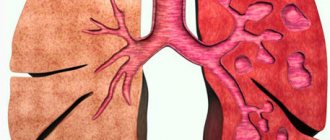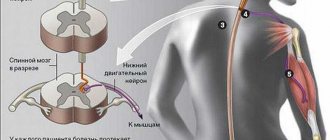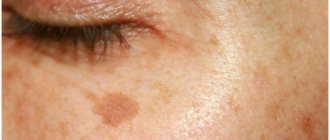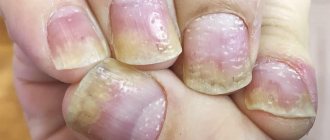Hemeralopia is the medical name for night blindness. It disrupts spatial orientation and deteriorates night vision. The popular name arose due to the similarity of the symptoms with the visual characteristics of chickens - they practically cannot see in the dark. The frequency of pathology according to statistics is 0.5%. At a young age, it occurs regardless of gender, and after 50 years, women predominate among patients.
Hemeralopia does not occur among the peoples of the North and in Australia. This is due to a natural genetic adaptability to dark vision and low light vision (polar nights).
Share
Tweet
Share
Cool
Send
What kind of disease is this
The receptor apparatus of the eye consists of rods and cones. Rods are needed for dark vision, and cones are responsible for color vision. Their number is measured in millions in a ratio of 18:1.
Rods contain rhodopsin, a visual pigment that provides dark adaptation. It disintegrates in the light, but with the participation of vitamin A it is restored in the dark.
If the ratio of cones and rods is abnormal or there is a lack of rhodopsin, hemeralopia develops.
Night blindness occurs with sudden changes in lighting and in low light conditions. It is based on organic changes in the rod cells, which are responsible for night vision, or a functional deficiency of visual purple, which is contained in these cells and helps the eye adapt to the dark. Such patients therefore cannot adapt to changes in lighting.
Kinds
Hemeralopia has 4 main types:
- Congenital type (congenital pathology of rods). It is detected in early or teenage years. It is not necessary for relatives to have night blindness. Other eye pathologies may be important: retinal developmental abnormalities, congenital retinitis pigmentosa, Usher syndrome.
- Symptomatic form. It is secondary because it occurs after certain diseases associated with damage to the retina. For example, with tapetoretinal dystrophy, glaucoma, retinal detachment, cataracts, radiation eye burns, high myopia, hypermetropia, optic nerve atrophy, chorioretinitis, siderosis.
- Essential type. The most common, its origin is associated only with a lack of vitamin A, B2 and PP and zinc. Disturbances can be caused by pathologies of the digestive tract, hepatobiliary system, chronic alcoholism, intoxication, anemia, diabetes, certain infections and prolonged exposure to ultraviolet rays. This form of hemeralopia accounts for 85% of all forms, but it is the easiest to treat.
- False night blindness is an additional form. Its cause is visual fatigue. There is no need for treatment. After rest everything goes away on its own.
Congenital
Congenital hemeralopia is most often inherited and manifests itself in adolescence or childhood. It is associated with disorders in the human genome. With congenital hemeralopia, there is a progressive deterioration of twilight vision and a lack of adaptation in the dark. This pathology cannot be treated.
Essential
This form of night blindness is associated with a deficiency of vitamin A, B2 and PP in the body or disturbances in their absorption. They are the ones who participate in the full maturation of light-receiving cells in the retina. The causes of such phenomena may be associated with diseases of the gastrointestinal tract, liver, fasting, vegetarianism, alcoholism, and malaria.
Reference! Sometimes night blindness becomes the first manifestation of the disease against the background of still complete well-being. This suggests that this form is temporary and disturbances occur in the retina.
Symptomatic
This form of disorder is associated with physical damage to light-receiving structures. In this case, the source is eye pathologies:
- high myopia;
- hypermetropia;
- dystrophic changes in the retina and blood vessels of the eye;
- glaucoma with high intraocular pressure;
- inflammation in the retina;
- optic neuropathy;
- the presence of a tumor pressing on the optic nerve;
- siderosis - accumulation of iron in the retina;
- cataract;
- eye injuries.
Night blindness in this form is complemented by the symptoms of these pathologies.
False
Caused by increased visual fatigue - these are many hours of vigil in front of the TV or computer, some professional costs. Such blindness is not considered a disease; it simply requires rest for the eyes. Treatment in this form is not required.
Description
Night blindness (nyctalopia, hemeralopia) is a disease in which vision is significantly reduced or completely lost in low light conditions. This happens because a person’s retinal ability to perceive light is impaired - the ability to perceive light of varying brightness, which is realized by retinal cells: rods and cones. There are many more rods on the retina than cones. The perception of light occurs as a result of a light wave hitting the membrane disk (the area of light-sensitive cells facing the pupil), which contains visual pigment, resulting in the formation of a nerve impulse. The rods contain the pigment rhodopsin, and the cones contain iodopsin. The rods are responsible for the perception of light levels, that is, twilight vision, and they also take some time to get used to. Cones contain several types of pigment, so they perceive different colors and instantly respond to changes in incoming information. Thus, impaired light perception may occur as a result of a decrease in the number of retinal rods, any changes in their structural organization, and due to a disruption in the formation of the light-sensitive pigment rhodopsin.
Night blindness can be congenital, symptomatic and essential.
- Congenital night blindness is a family hereditary disease. There is an assumption that the inheritance of night blindness occurs on the maternal line, and the disease manifests itself in males, and women become carriers of the genes, that is, linked to the X chromosome.
- Symptomatic night blindness can accompany both eye diseases (glaucoma, optic neuritis, retinal dystrophy, high myopia, chorioretinitis) and general diseases (anemia, pigmentopathy, exhaustion, past infectious diseases, especially those associated with dehydration).
- Essential night blindness develops due to a lack of vitamin A, since it is part of rhodopsin. In severe cases, hypovitaminosis may be accompanied by the formation of xerotic plaques (a white coating of exfoliated epithelial cells, usually in the corner of the eye).
Vitamin A, being a fat-soluble vitamin, is absorbed in the small intestine. With food, the body mainly receives its precursor - carotene, found in vegetables and fruits. In the human liver, it is converted directly into vitamin A - retinol. Retinol, since it is not produced in the body, tends to accumulate, so symptoms of its deficiency do not appear immediately after changing the diet, but after several months. Therefore, an excess of vitamin A can be harmful. An excess of vitamin A in the body can cause nausea, vomiting, drowsiness, redness of the face and cervical-collar area, and menstrual irregularities in women. For pregnant women, in particular, hypervitaminosis A threatens miscarriage, miscarriages and fetal development abnormalities. People whose diet consists of vegetables containing carotene (carrots, tomatoes, bell peppers) may experience side effects such as orange skin color.
As mentioned, vitamin A deficiency can develop with a change in diet, that is, exclusion of fresh fruits, vegetables and liver from the diet. But hypovitaminosis can be caused not only by a lack of vitamin A in food, but also by various diseases of the gastrointestinal tract, which impair its absorption. Symptoms of night blindness are observed with varying frequency in people who suffer from malabsorption syndrome, cystic fibrosis, gluten intolerance, hepatitis, pancreatitis, and alcoholism.
Night blindness can occur at any age, equally often in men and women, but is more common in older people and people over 45 years of age, due to a slowdown in metabolic processes.
Causes
Reasons include:
- genetic predisposition;
- anemia;
- retina lesions (retinitis pigmentosa, detachment, inflammation and dystrophy, etc.);
- exhaustion of the body;
- liver pathologies (the absorption of vitamin A and its synthesis are impaired);
- taking vitamin A antagonists (quinine, antiplatelet agents);
- deficiency of vitamins;
- diets (especially vegetarianism);
- myopia and hypermetropia;
- cataract and glaucoma;
- strabismus;
- inflammation of the optic nerve;
- transfer of viral infections - if they cause complications in the eyes;
- skull injuries;
- menopause (retinal nutrition is disrupted);
- pregnancy;
- poor lighting when working;
- frequent and prolonged exposure to bright sun (ultraviolet burn of the mucous membrane).
Symptoms
There is no connection between the clinic and the form of the disease; the main symptoms will always be the same:
- decreased vision at dusk: a person sees the outlines of objects very blurry;
- the appearance of a feeling of fog around;
- loss of color around, especially blue and less yellow;
- spots before the eyes;
- cutting pain in the eyes;
- reduction in the volume of the field of view.
Children with night blindness have another important symptom - they begin to be afraid of the dark and become restless in the evenings.
As dusk sets in, a man with night blindness turns on the lights everywhere, claiming that it is very dark. Twilight is quite comfortable for a healthy person, but for a sick person it is impenetrable darkness. Against this background, the patient often complains of a feeling of “sand” in the eyes or pain. In the morning everything goes away. With prolonged hemeralopia, the result can be myopia.
Expert opinion
Kim Oksana Alexandrovna
Head of the ophthalmology clinic. Ophthalmologist with more than 10 years of experience.
Vitamin A deficiency in essential hemeralopia can also be suspected by extraocular manifestations: dry skin, hair loss, brittle nails and sticking in the corners of the mouth, bleeding gums, and the appearance of rough skin thickening. This is often accompanied by itching and scratching of the skin.
If vitamin A is not supplied at all, the cornea of the eye softens and ulcerations appear on it - this is keratomalacia.
The bad thing is that with night blindness, vision deterioration occurs gradually and the person realizes it late.
For congenital pathology:
- progressive vision loss occurs from early childhood;
- there is visual discomfort in the dark;
- characterized by spatial disorientation in poorly lit places;
- anxiety increases in the evenings.
Important! Reduced dark vision in one eye does not occur with night blindness; both eyes are affected, so deterioration of vision in one eye requires examination by an ophthalmologist.
Classification
The international classifier distinguishes four types of hemeralopia:
- Congenital.
- Symptomatic.
- Essential.
- False.
Congenital
Pathology occurs in childhood or early adolescence. Its appearance is due to genetic factors. Congenital night blindness can occur due to the following diseases:
- hereditary pigmentary rhinitis;
- Usher syndrome.
Children experience progressive deterioration of vision in the dark and poor spatial orientation at dusk. Visual dysfunction is persistent.
Symptomatic
It develops under the influence of external factors or pathologies present in the body. Most often, the causes of the disease are associated with ophthalmological disorders that cause damage to the retina.
Symptomatic hemeralopia is the most unpredictable. As a result, a person may develop an adaptation to low light levels, or he may permanently lose his vision.
Essential
It develops against the background of retinol deficiency or when its metabolism is disrupted. Night blindness can be caused by chronic dieting, starvation, poor diet, chronic alcoholism or malaria. The reason also sometimes lies in liver disease, anemia or severe exhaustion of the body. This type of hemeralopia is temporary and is the easiest to treat.
False
And it is also worth noting such a phenomenon as false night blindness. What does it mean? A person experiences slight deviations in vision at dusk due to eye fatigue, for example, when working at a computer for a long time or constantly watching TV. This type of hemeralopia cannot be treated and goes away on its own after rest.
Why is it dangerous?
Night blindness in itself does not threaten human life, but it cannot be called a harmless condition either. It can completely deprive a person of vision. Dry eye syndrome often develops with night blindness.
It is also worth noting that this pathology develops with serious causative diseases that cannot be ignored. The lack of vitamins in itself (in addition to night blindness) depletes the structures of the eye and leads to complications such as glaucoma, cataracts, etc.
Night blindness can also cause problems such as physical injuries due to a person’s impaired orientation in space and the appearance of psychological problems, or getting into accidents.
Medical designation of the disease night blindness and its synonyms
Night blindness is the popular name for the disease. In the Russian terminological tradition it is referred to as hemeralopia. The term “hemeralopia” is formed from three Greek words - “hemer”, “ala”, “op”, which are translated into Russian, respectively, as “day”, “blind”, “sight”. That is, the final translation of the term is “day blindness”.
A literal translation does not reflect the essence of the disease, since with night blindness a person sees poorly at night and in the evening, and not during the day. However, this particular term in the post-Soviet space has been used to refer to twilight vision impairment for more than a hundred years.
Doctors in English-speaking countries use another term to refer to night blindness - “nyctalopia”. The term “nyctalopia” is also derived from three Greek words “nyct”, “ala”, “op”, which are translated, respectively, “night”, “blind”, “sight”. Accordingly, the final full translation of the term “nyctalopia” is night blindness.
As you can see, nyctalopia fully corresponds to the essence and meaning of the disease that people call night blindness.
The terms “nyctalopia” and “hemeralopia” in the mouth of an English-speaking and Russian-speaking doctor, respectively, will be synonyms denoting one disease, known by its popular name as night blindness.
Diagnostics
Diagnostics includes the following activities:
- Visometry - this procedure is familiar to everyone who has ever been examined by an ophthalmologist for visual acuity using Sivtsev’s letter table.
- Perimetry - determination of visual fields using a special device.
- Examination of the fundus with an ophthalmoscope. In this case, you can see the condition of the blood vessels, the retina and the condition of the optic nerve head. The fact is that the picture of the fundus differs in different forms. With essential hemeralopia there are no changes; with the congenital form, small foci of degeneration are visualized in the fundus.
- Tonometry is the measurement of intraocular pressure.
- Biomicroscopy of the eyes - using a Goldmann lens.
- Refractometry is a more detailed diagnosis prescribed for symptomatic hemeralopia. This is a test of the refractive power of the eye to detect ametropia.
- Electroretinography is a method for diagnosing the functional state of the retina.
- Ultrasound of the fundus of the eye - shows pathologies of the optic nerve head, visual impairment, clouding of the lens, retinal detachment, the presence of a tumor.
Treatment of poor vision at dusk
Congenital nyctalopia cannot be treated. In this case, you can only maintain the existing state of vision and prevent its deterioration with the development of complications. For the treatment of acquired forms, it becomes important to establish the root cause of the pathology.
If there are causative diseases, they are treated first. Particular attention is paid to the absorption of vitamins in the digestive tract, treatment of concomitant organic eye lesions and other diseases.
Essential hemeralopia requires only a diet. If it is associated with myopia or farsightedness, vision correction can be carried out by selecting glasses or lenses. In some such cases, surgery is required.
In any form of night blindness, the basis for successful treatment of the disease is the consumption of foods rich in vitamins (especially A). Vitamin eye drops and oral nicotinic acid are also prescribed.
Nutrition
Nutrition is especially important in essential hemeralopia; in this form, a special diet becomes the basis of treatment. Nutrition should be balanced and high in calories.
Particular attention is paid to the vitamin content of the diet. For this purpose, the following become mandatory:
- fatty fish, cod liver, caviar, squid, seaweed;
- red meat, beef liver and turkey;
- fermented milk products - cheese, cottage cheese, sour cream;
- butter;
- egg yolks;
- millet;
- from fruits and berries - blueberries, apricots, peaches, currants, blackberries, cherries and gooseberries, sea buckthorn;
- vegetables and green crops - lettuce, spinach, parsley, pumpkin juice, tomatoes, green onions and peas, special attention is paid to carrots in any form: with butter, cream, in the form of juice, decoction.
It is useful and necessary to include 2-3 products from the above in your diet every day.
It is also recommended to consume sea buckthorn daily and drink blueberry juices and fruit drinks. Blueberries contain a special substance - anthocyanoside, which stimulates the production of rhodopsin - a light-receiving pigment in the retina.
Vitamin A is also better absorbed in the presence of not only zinc, but also vitamin E, and it is found in nuts, broccoli, seeds, and potatoes.
The diet also helps with congenital nyctalopia, maintaining the existing state of vision and preventing complications from developing.
Narrowing of visual fields cannot be cured by diet.
Medicines
For night blindness, drug treatment consists of taking vitamins A, B2 and PP. For symptomatic and essential forms of hemeralopia, treatment is aimed at eliminating the causative pathologies. Eye drops and ointments may also be prescribed to eliminate existing eye diseases. Supplements for the eyes are recommended, for example, Flavigran.
Drops
First of all, for nyctalopia, the doctor prescribes drops of vitamin B2. The drug contains a concentrated solution of riboflavin, which directly affects the tissues of the eyes and allows them to normalize their functioning. The drops help saturate the eye tissues with oxygen, make it easier to conduct nerve impulses and normalize all types of metabolism.
Drops can also be prescribed Taufon, Tobrex, Tsipromed, Normax, Dancil, Floxal, etc.
Dosage: 1 drop in each eye in the evening, for an average of 15 days.
Important! Allergic reactions may occur to the use of some drugs.
Vitamins
Treatment of night blindness is based on increasing the intake of vitamin A into the human body. It is usually prescribed:
- adults 50–100 thousand IU per day;
- children – 1000-5000 IU per day.
Vitamin B2 (riboflavin) is also indicated - 20 mg per day.
The total period of taking vitamins should be at least 2 months. Afterwards, the timing and dosage of drug use are adjusted by an ophthalmologist.
Balanced complexes of B vitamins: Neurobion, Neurostabil, Vita B Plus, Vita-Escort, Vitabalance 2000, B-50.
People's Councils
Non-traditional recipes can be used to assist with night blindness. Let's talk about the most proven recommendations of the populists:
- Millet decoction. A glass of the product should be filled with two liters of water. The millet should be cooked until it is completely dissolved. The strained solution should be taken half a glass thirty minutes before meals for three weeks.
- Carrot juice. Every day in the morning, half an hour before meals, drink a quarter glass of freshly squeezed carrot juice. A teaspoon of vegetable oil should be added to it. The treatment course lasts two weeks.
- Rose hip decoction. Pour three tablespoons of dried fruit into 500 ml of water and cook for ten minutes. The cooled and strained liquid should be taken one third of a glass three times a day for four weeks.
- Sea buckthorn. Eat a glass of fresh or frozen berries a day.
- Blueberry. During the season, eat a glass of fresh berries daily.
- Herbal collection. Take lingonberry, blackberry, raspberry, black currant, viburnum, lemon balm leaves and snake knotweed roots in equal proportions. Pour a tablespoon of raw material into a glass of boiling water and leave. Take the strained liquid throughout the day. The course of treatment is one month.
So, night blindness is a pathological process in which a person cannot see and navigate in the dark. The disease can be congenital or acquired. Hemeralopia in childhood is often associated with genetic abnormalities. The development of the acquired form may be due to a lack of vitamin A. False night blindness occurs due to visual fatigue.
Hemeralopia can be effectively treated, but only if it is a non-congenital form. Patients are advised to lead a healthy lifestyle, eat right and follow preventive measures. If you notice a deterioration in your twilight vision, do not self-medicate, consult a doctor immediately. Hemeralopia may conceal more dangerous diseases that can negatively affect visual function.
Prevention
Prevention of hemeralopia is primarily associated with the elimination of vitamin A deficiency and measures to protect the retina of the eye, this means:
- be sure to wear sunglasses with an ultraviolet filter;
- when working with harmful radiation, use special glasses and screens;
- The lighting of the workplace must be correct;
- patients with hemeralopia should not use fluorescent lamps (fluorescent light - gas-discharge light sources);
- children with mild myopia use glasses at dusk;
- eliminate the passion for solarium;
- control visual stress;
- with nyctalopia, avoid bright light sources - welding, car headlights, etc.











